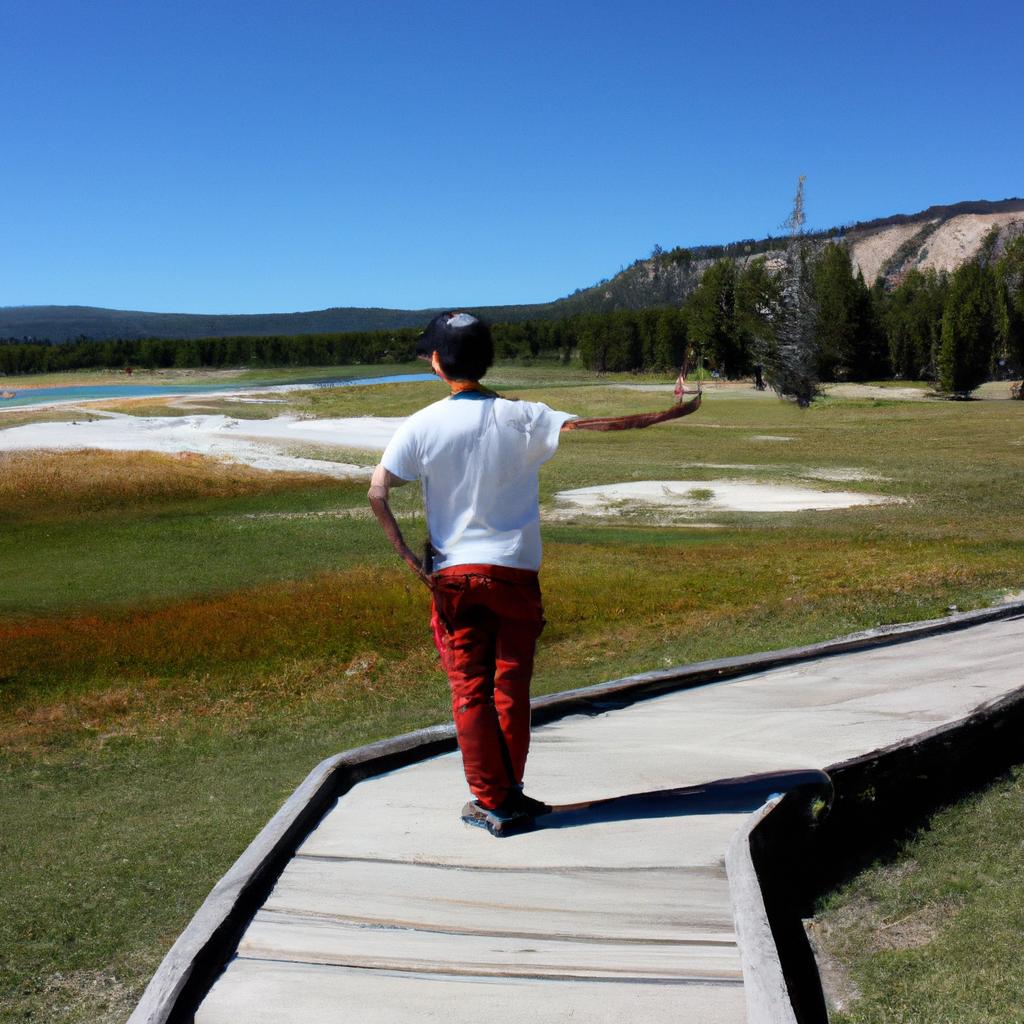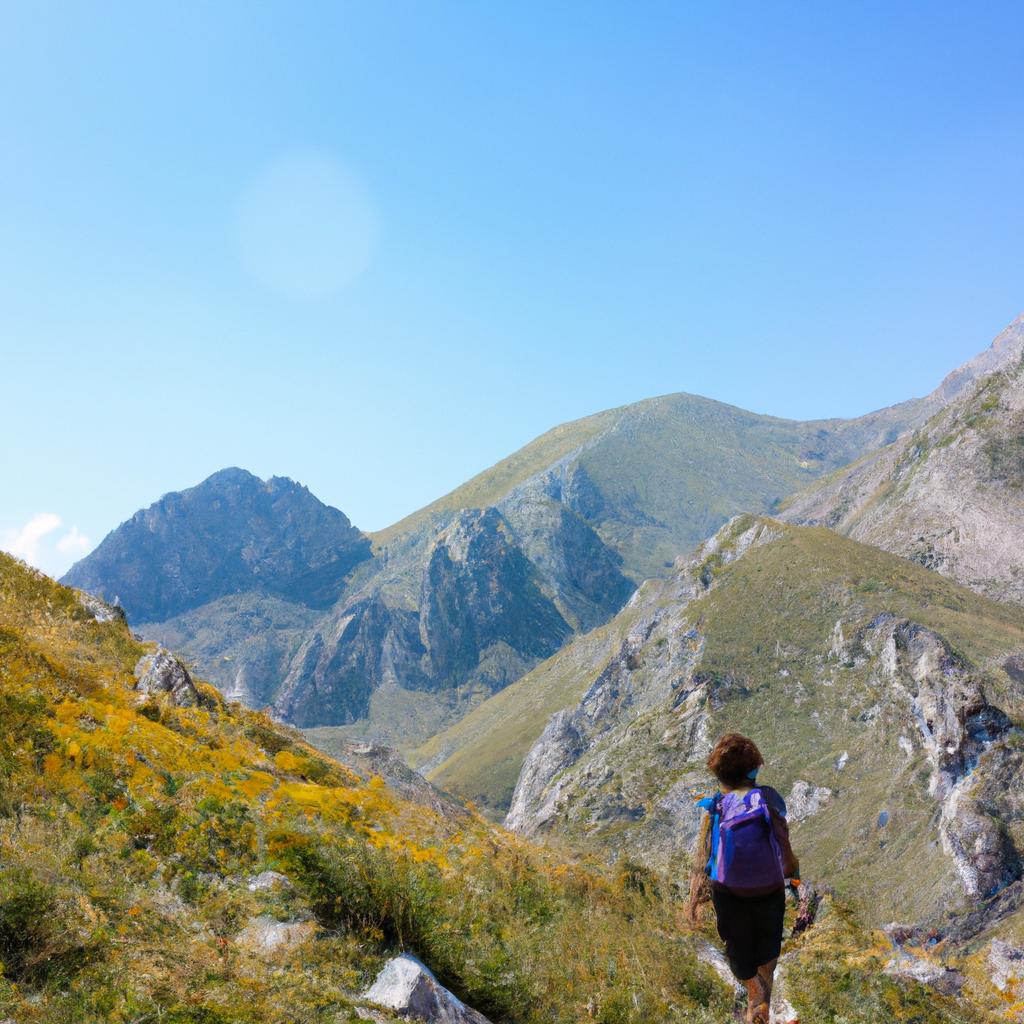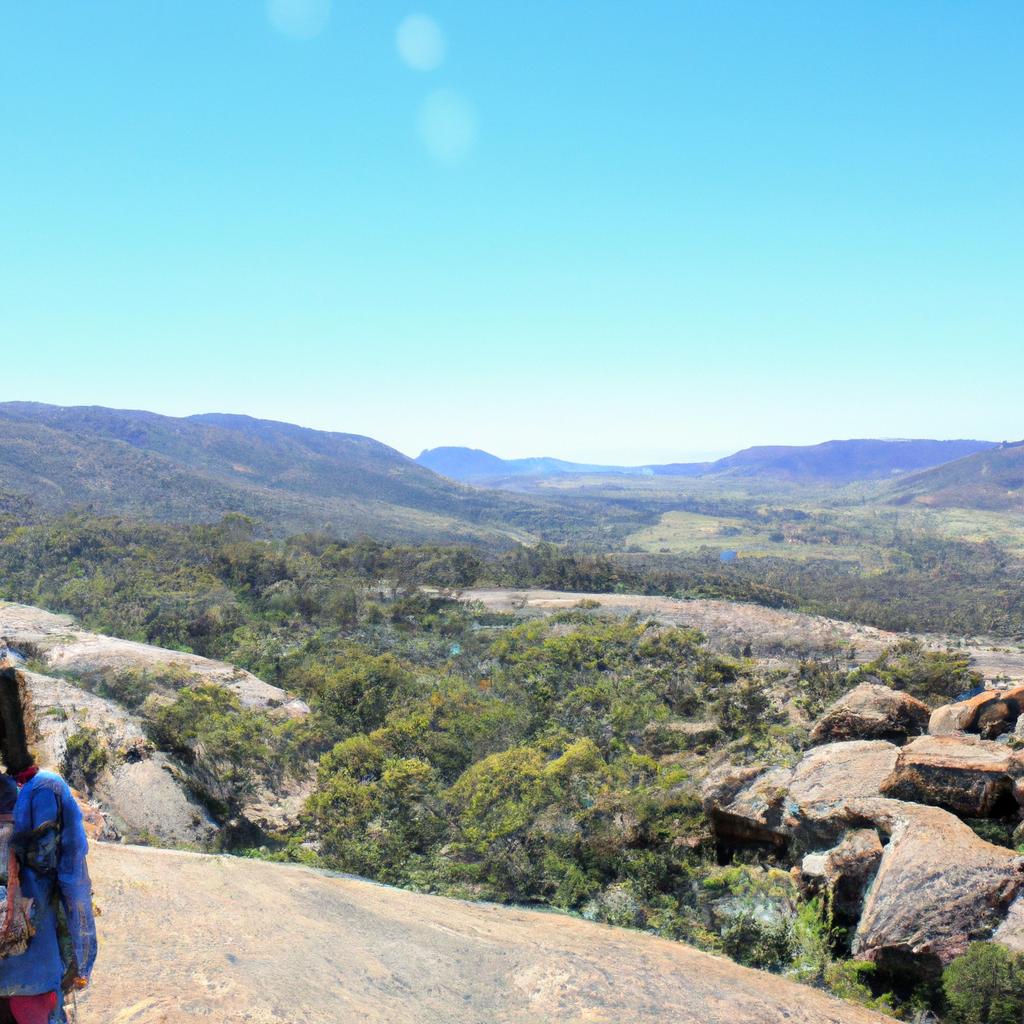The Rocky Mountain region in North America is home to a diverse range of national parks, each offering unique landscapes and experiences for visitors. These protected areas serve as havens for wildlife, promote conservation efforts, and provide opportunities for outdoor recreation and exploration. This article serves as a comprehensive guide to the national parks in this region, highlighting their individual characteristics, ecological significance, and recreational activities available.
For instance, let us consider the case of Yellowstone National Park. Situated primarily in Wyoming but also extending into Montana and Idaho, Yellowstone boasts an unparalleled array of geothermal features including hot springs, mudpots, and geysers such as the world-renowned Old Faithful. Beyond its geothermal wonders, Yellowstone is also renowned for its abundant wildlife populations; it provides a sanctuary for iconic species such as grizzly bears, wolves, elk, and bison. With its vast wilderness areas and stunning natural beauty, Yellowstone’s designation as the first national park in the United States in 1872 marked a milestone not only in American conservation history but also globally.
Rocky Mountain: An Overview
Imagine standing on a precipice, overlooking the vast expanse of rugged mountains with snow-capped peaks. The air is crisp, and the silence is broken only by the distant call of an eagle soaring through the clear blue sky. This breathtaking scene encapsulates the essence of Rocky Mountain National Park, one of North America’s most iconic national parks.
A Natural Wonder
Rocky Mountain National Park spans over 415 square miles in Colorado, United States. Established in 1915, it offers visitors a unique opportunity to explore a diverse range of ecosystems and experience nature at its finest. From alpine tundra to dense forests, this park boasts an impressive array of landscapes that are home to countless species of flora and fauna.
Visitors to Rocky Mountain National Park can expect:
- Unparalleled scenic beauty
- Endless opportunities for outdoor recreation
- Educational experiences offered by park rangers
- Preservation and protection of natural resources
| Scenic Beauty | Outdoor Recreation | Educational Experiences | |
|---|---|---|---|
| 1. | Majestic mountain ranges | Hiking trails | Guided ranger-led programs |
| 2. | Tranquil lakes and cascading waterfalls | Camping spots | Informative visitor centers |
| 3. | Vibrant wildflower meadows | Wildlife viewing | Interactive exhibits |
| 4. | Diverse wildlife habitats | Fishing opportunities | Interpretive signs along trails |
As you immerse yourself in the wonders Rocky Mountain has to offer, keep your eyes peeled for some remarkable creatures – from elk gracefully grazing in open meadows to elusive black bears roaming through thick forests. In our next section, we will delve into the captivating world of wildlife found within this extraordinary national park.
[Transition] Now let us explore the fascinating wildlife that calls Rocky Mountain home.
[Next Section: Wildlife in Rocky Mountain]
Wildlife in Rocky Mountain
The Rocky Mountain National Park is a sanctuary for wildlife, offering diverse habitats and abundant species. One remarkable example of the park’s thriving wildlife population is the elk (Cervus canadensis). These majestic creatures can be found throughout the park, exhibiting their impressive antlers during mating season. The presence of such magnificent animals not only adds to the natural beauty of the park but also provides visitors with unique opportunities for observation and appreciation.
When exploring the wildlife in Rocky Mountain National Park, it is essential to keep certain considerations in mind:
- Respect Wildlife: While observing animals in their natural habitat, maintain a safe distance to ensure both your own safety and that of the animals. It is crucial to respect their space and refrain from feeding or approaching them.
- Binoculars and Cameras: To enhance your viewing experience without disturbing the wildlife, bring binoculars or a camera with zoom capabilities. This allows you to get closer views while maintaining an appropriate distance.
- Be Mindful of Seasonal Changes: Different seasons offer different opportunities for wildlife sightings. Researching seasonal patterns can help maximize your chances of spotting specific species at particular times.
- Follow Park Regulations: Familiarize yourself with all relevant regulations regarding wildlife interactions within the national park boundaries. Adhering to these rules ensures minimal disruption to animal behavior and preserves their natural environment.
Here is a look at some captivating inhabitants you may encounter during your visit:
| Species | Description | Notable Behavior |
|---|---|---|
| Bighorn Sheep | Distinguished by large curved horns | Engage in head-butting battles for dominance |
| Black Bear | Omnivorous mammals known for their adaptability | Hibernate during winter months |
| Moose | Largest members of deer family | Often seen near water sources |
| Peregrine Falcon | Fastest bird in the world | Dive at high speeds to catch prey |
By respecting wildlife, utilizing appropriate viewing equipment, and following park regulations, visitors can enjoy a fulfilling experience while ensuring the preservation of Rocky Mountain National Park’s diverse ecosystem.
Transitioning towards the subsequent section on “Hiking Trails in Rocky Mountain,” nature enthusiasts are encouraged to explore further into this magnificent landscape. The park offers an extensive network of trails that allow for deeper immersion within its breathtaking scenery. Whether you seek challenging treks or leisurely walks, these hiking trails provide unparalleled opportunities to discover hidden gems amid the grandeur of Rocky Mountain National Park.
Hiking Trails in Rocky Mountain
As visitors explore the breathtaking landscapes of Rocky Mountain National Park, they are often captivated by the geological wonders that shape this remarkable natural environment. One notable example is the iconic Longs Peak, towering at an elevation of 14,259 feet and serving as a prominent peak in the Front Range of the Colorado Rockies. Its jagged granite summit challenges even seasoned climbers to conquer its sheer vertical faces.
To fully appreciate the diverse geological features found within Rocky Mountain National Park, it is essential to understand some key aspects. Here are several significant elements that contribute to the park’s unique geology:
- Faulting and Uplift: The region has experienced considerable tectonic activity over millions of years. The movement along fault lines has led to dramatic uplift, forming majestic mountain ranges like those found in Rocky Mountain.
- Glacial Activity: In the not-so-distant past, glaciers carved through valleys and sculpted distinctive landforms such as cirques, tarns, moraines, and U-shaped valleys. These remnants from the ice age showcase nature’s powerful forces.
- Sedimentary Layers: Beneath alluring alpine meadows lie layers upon layers of sedimentary rocks. These rock formations reveal ancient environments ranging from marine fossils indicative of prehistoric oceans to terrestrial deposits indicating vast plains once covered with lush vegetation.
- Erosion and Weathering: Wind, water, frost action, and gravity continue to shape Rocky Mountain’s landscape today. Through erosion and weathering processes, cliffs erode into talus slopes while streams carve deep canyons – constant reminders of nature’s transformative power.
To further illustrate these geological phenomena within Rocky Mountain National Park:
| Geological Feature | Description |
|---|---|
| Moraine | Accumulation of glacial debris formed by moving ice masses; visible evidence of past glacial activity |
| Cirque | Amphitheater-like hollows formed by glacial erosion; often have a lake nestled at their base |
| Tarn | Small mountain lake occupying a cirque depression, usually characterized by its crystal-clear water |
| Fault Line | A fracture along which the Earth’s crust has moved, resulting in visible displacement of rock layers |
The geological wonders found within Rocky Mountain National Park are an enduring testament to the forces that shape our planet. Understanding these natural processes enhances both appreciation and enjoyment for visitors as they explore this awe-inspiring landscape.
Transitioning into the subsequent section on “Camping in Rocky Mountain,” it is essential to consider how geology plays a role in providing suitable camping areas and understanding potential hazards while immersing oneself in the park’s rugged beauty.
Camping in Rocky Mountain
Imagine yourself standing at the trailhead of a hiking trail in Rocky Mountain National Park, surrounded by towering peaks and pristine alpine meadows. The possibilities for exploration and adventure are endless. Whether you’re an experienced hiker seeking a challenging summit or a casual nature lover looking for a scenic stroll, the park offers an array of trails to suit every interest and ability.
Here are some key features that make hiking in Rocky Mountain an unforgettable experience:
-
Diverse Terrain: From gentle valley hikes to steep mountain ascents, the park boasts a wide range of terrains that cater to different preferences. Traverse through dense forests filled with spruce and fir trees, cross babbling streams on wooden footbridges, and find yourself immersed in breathtaking landscapes as you climb higher into the mountains.
-
Abundant Wildlife: As you explore the trails of Rocky Mountain, keep your eyes peeled for glimpses of its diverse wildlife. Spot majestic elk grazing in open meadows, encounter herds of bighorn sheep scaling rocky slopes with ease, and if you’re lucky, catch sight of elusive predators like black bears or mountain lions roaming their natural habitat.
-
Spectacular Views: One cannot talk about hiking in Rocky Mountain without mentioning the awe-inspiring vistas that await at various vantage points along the trails. Ascend above treeline and be rewarded with sweeping panoramas of snow-capped peaks stretching as far as the eye can see. Take a moment to soak in these breathtaking views and appreciate the grandeur of North America’s wilderness.
-
Ecological Diversity: Rocky Mountain National Park is renowned for its rich biodiversity, boasting over 60 different ecosystems within its boundaries. While exploring the trails, marvel at the variety of plant life ranging from delicate wildflowers carpeting high alpine meadows to ancient bristlecone pines clinging to rocky outcrops. Each step reveals new wonders of nature’s intricate tapestry.
Embrace the opportunity to immerse yourself in the wonders of Rocky Mountain National Park through its extensive network of hiking trails. Lace up your boots, pack some essentials, and embark on a journey that will leave you with lasting memories of natural splendor.
Transitioning into the subsequent section about “Scenic Drives in Rocky Mountain,” visitors can further explore the park’s beauty from the comfort of their vehicles. Discover breathtaking vistas, hidden gems, and captivating landscapes as you traverse the scenic drives that wind through this remarkable national park.
Scenic Drives in Rocky Mountain
As you explore the vast wilderness of Rocky Mountain National Park, you will be captivated by its diverse and abundant wildlife. From majestic elk grazing in meadows to elusive mountain lions prowling through the forests, this park is teeming with fascinating creatures. In this section, we will delve into the captivating world of wildlife in Rocky Mountain.
Wildlife Diversity:
One example that highlights the remarkable diversity of wildlife within the park is the presence of bighorn sheep. These impressive animals, known for their distinctive curved horns, can be found scaling steep cliffs and rocky slopes. Their ability to adapt to such challenging terrain showcases their resilience in an ever-changing environment.
To further appreciate the incredible variety of wildlife in Rocky Mountain, consider the following aspects:
- Species richness: More than 60 mammal species call this national park home.
- Avian wonders: Over 280 bird species have been documented here, ranging from delicate hummingbirds to soaring eagles.
- Aquatic life: Numerous fish species inhabit the crystal-clear lakes and streams throughout the park.
- Small wonders: Delight in observing a multitude of small mammals, including chipmunks scurrying among trees or marmots sunning themselves on rocks.
Case Study: The American Black Bear
The American black bear (Ursus americanus) serves as a fascinating case study when examining wildlife encounters within Rocky Mountain National Park. While these bears are generally shy and avoid human contact, it’s essential to adhere to proper safety protocols if encountering one during your visit. By keeping a respectful distance and properly storing food away from campsites, visitors can ensure both their own safety and that of these magnificent creatures.
Table: Notable Wildlife Species in Rocky Mountain
| Mammals | Birds | Fish | Amphibians |
|---|---|---|---|
| American Bison | Bald Eagle | Cutthroat Trout | Boreal Toad |
| Mountain Lion | Peregrine Falcon | Rainbow Trout | Western Tiger Salamander |
| Moose | White-throated Swift | Brook Trout | Northern Leopard Frog |
| Gray Wolf | Steller’s Jay | Brown Trout | Long-toed Salamander |
Final Thoughts:
As you venture through Rocky Mountain National Park, take a moment to appreciate the rich tapestry of wildlife that surrounds you. Remember, observing these animals from a respectful distance ensures their safety and well-being. Now let us explore the best time to visit Rocky Mountain and witness its natural wonders in full bloom
Best Time to Visit Rocky Mountain
Exploring the Wildlife of Rocky Mountain National Park
Imagine standing on a lush green meadow, surrounded by towering mountains and crystal-clear lakes. Suddenly, you spot a majestic elk grazing peacefully in the distance. This is just one example of the captivating wildlife encounters that await visitors to Rocky Mountain National Park. In this section, we will delve into the diverse range of animal species that call this park home.
As you venture through the vast wilderness of Rocky Mountain National Park, keep your eyes peeled for these fascinating creatures:
- Elk: The park’s emblematic species, elks can often be seen in large herds during their mating season.
- Bighorn Sheep: Known for their impressive curved horns, bighorn sheep gracefully navigate the rocky terrain.
- Moose: With their massive bodies and iconic antlers, moose are a sight to behold as they traverse wetlands and browse on vegetation.
- Black Bears: Although elusive, black bears occasionally emerge from hibernation to search for food and explore their surroundings.
| Species | Habitat | Notable Behavior |
|---|---|---|
| Elk | Meadows | Bugling during rut |
| Bighorn Sheep | Alpine areas | Climbing steep cliffs |
| Moose | Wetlands | Feeding underwater |
| Black Bears | Forests | Foraging for berries |
This table provides an overview of where each species typically resides within the park and highlights some intriguing behaviors unique to each animal.
In conclusion,
the remarkable wildlife found within Rocky Mountain National Park adds an extra layer of allure to its already stunning scenery. As you embark on your journey through this natural paradise, remember to respect these animals’ habitats by observing them from a safe distance and refraining from any disruptive behavior. By doing so, you can contribute to the preservation of this precious ecosystem for generations to come.
 Island Gourmet Safaris
Island Gourmet Safaris



